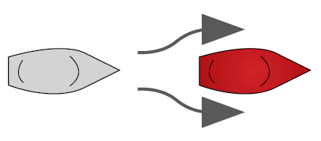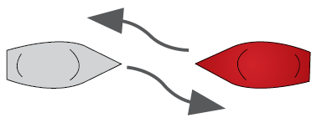Safe boating rules
Here we provide you with some general tips and key bylaws to stay safe when boating in Northland.
Safe boating information and videos
Navigation Safety Bylaw 2017
Get a copy of the bylaw
For a copy of all the rules when boating in Northland, go to:
The Navigation Safety Bylaw 2017 – online and PDF format
Infringements and fees
Fines can be issued by our staff for breaching the 2017 Navigation Safety Bylaw.
Sit back and relax as we take you through this short safety briefing.
Lifejackets/personal flotation devices
You must wear a lifejacket if:
- you are on a vessel 6 metres or less when it's underway*
- there is a heightened risk, such as crossing a bar or adverse weather
- you are being towed, i.e. ski biscuit, wakeboarding or water skiing.
*Underway means not aground, anchored or fixed to the shore.
*For further information on this, see the Navigation Safety Bylaw 2017.
It is a requirement to carry correctly fitting lifejackets for each person on board.
Dive flags – safety rules
Protect our divers
- All vessels must display a dive flag whenever there are divers in the water. The skipper must ensure the vessel is within 200 metres of the diver.
- Divers should stay within 200 metres of the vessel showing the flag.
- Vessels shall observe the 5 knot speed limit around dive flags.
- The flag must be no smaller than 600mm x 600mm. It must be easily identified by another vessel at a distance of 200 metres or more.
You must display a dive flag when divers are in the water.
Speed and wakes
Slow down to 5 knots (including while towing a person or an object) when:
- within 50 metres of a boat, raft, or person in the water
- within 200 metres of the shore
- within 200 metres of a dive flag.
Ensure your wake does not cause unnecessary danger or risk of damage to other vessels or structures, or harm to other people.
Be considerate and always check the effects of your wake.
Minimum age
No person under the age of 15 years can be in charge of, or propel or navigate a power-driven vessel that is capable of a proper speed exceeding 10 knots.*
Boat safety checklist
Before you go:
- Check the marine weather forecast. If in doubt, don’t go out.
- Tell someone where you’re going and when you’ll be back.
- Have these things on board:
- lifejackets fit for purpose for everyone
- spare fuel, oars and a bailer
- anchor with chain and rope
- distress signals (flares)
- fire extinguishers
- charts of the area
- two methods of communication, eg. VHF and a cellphone
- Emergency Position Indicating Radio Beacon (EPIRB), especially outside harbour limits.
- Ensure your boat maintenance is up to date.
- Log your trip report with Coastguard.
Golden rules for safe boating
- The skipper is legally responsible for everyone on board. Be clear who's in charge.
- Make sure you have enough fuel, and some in reserve.
- Keep your motor well maintained.
- Don't overload your boat.
- Lifejackets of the right size must be carried for every person on board, and worn on vessels 6 metres or less when underway.
- Show your passengers where the safety gear is and how it works.
- Keep a good lookout at all times.
- Know the "Rules of the road at sea".
- Know the area you’re boating in. Use a chart if you don't. Navigational charts are available at www.linz.govt.nz and local marine chandleries.
- Don't drink and go boating.
- Anchor carefully so your boat doesn't drag or swing around and damage other craft.
Power boats must give way to boats under sail.
Overtaking boats
All boats, sail or power, overtaking from astern (behind) must keep clear until they are well past the boat being overtaken. The boat in front may not be aware of your presence or intentions.

Power boats meeting head on
Each boat must alter course to starboard (right) to pass on the port (left) side of the other – the opposite to driving on the road.

Power boats meeting on an angle (crossing)
Give way to boats on your starboard (right) side.

In narrow channels, all boats must:
- give ways to ships, as they may not be able to change course or stop easily
- keep as far over to the starboard side of the channel as practicable
- avoid anchoring in a channel, and
- avoid crossing a channel if this prevents a larger boat with no room to move from doing so.
Within harbour limits:
- recreational craft are required to keep clear of ships over 500gt.
To find information about the rules of collision prevention, requirements for the display of navigation lights, safe speed and look-out requirements, download the Maritime Rules Part 22: Collision Prevention from the Maritime New Zealand website.
See and be seen
You must keep a good lookout at all times. It is your responsibility to stay alert for other boats, swimmers, dive boats, hazards and obstacles. Listen as well as look.
Check that you display the correct navigation and anchor lights for your boat's size.
Watch out for ships
Anchoring is legally prohibited in the Waitangi sector light zone when big ships are moving in and out. For your own safety – and that of the ships – it is advisable not to anchor in this sector light zone at any time.
See the Harbourmaster's Directions for more information
Report a boating accident or grounding
The reporting of boating accidents and groundings helps to improve navigation safety. Accidents do happen, but with knowledge of existing problems, resources can be allocated to improve safety.
The Northland Regional Council installs and maintains the ‘Aids to Navigation’ (buoys, beacons and lights) in the region, and these are provided where they are most needed.
We also provide safety signage and information booklets, and work with other regions around the country towards improving safety on the water. Future planning is based on the information we have, so please assist by sending in an accident report form, if applicable.
Notifiable accidents include:
- collision, sinking, grounding, stranding, injury to any person, damage to vessel or property, or
- any incident that may affect safe navigation, or give rise to danger to another person, vessel or property.
Notification can be made at any Northland Regional Council office. Immediate notification can be made by calling the 24/7 Environmental Hotline on 0800 504 639.
For further information, see the Northland Regional Council Safety Bylaw 2017 section 2.10, or freephone 0800 002 004 and ask to speak to a member of the maritime team.
